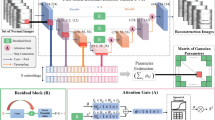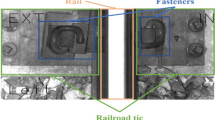Abstract
With the rapid development of high-speed railways, the safety inspection requirements for supporting devices of high-speed railway catenary components have become increasingly stringent. Currently, defect detection tasks for catenary equipment heavily rely on manual judgment, which is labor-intensive, inefficient, and prone to missing defects. Furthermore, high-speed railway catenary components present a myriad of challenges, including varying sizes, multiple defect types, and a limited number of defects. This complexity makes it difficult to address these issues using a single approach, and Few-Shot defect detection tasks are particularly challenging to achieve using deep learning methods. In this article, we propose a novel SCA-GANomaly model based on the GANomaly network, specifically designed to overcome the challenges of few-shot defect detection by utilizing only normal high-speed railway catenary images for training. The model incorporates selective skip connections and hybrid attention mechanisms, and the loss function is optimized using Earth Mover(EM) Distance, effectively improving image reconstruction and enhancing training stability for high-speed railway catenary images. We conduct comprehensive experiments and evaluations on three types of components: Insulators, Oblique Bracing Wires(OBW), and Puller bolts. The results demonstrate the excellent generalization capabilities of our proposed model, significantly outperforming the GANomaly model in terms of defect detection performance. Specifically, the AUC values for Insulator defect detection increased by 0.15, OBW defect detection by 0.10, and Puller bolts defect detection by 0.12.


















Similar content being viewed by others
Data availability
The dataset used in this study contains sensitive information and therefore its data are subject to strict confidentiality. To maintain the confidentiality and security of the data, we are unable to share access to this dataset publicly.
References
Han Y, Liu Z, Han Z, Yang HM (2014) Fracture detection of ear pieces of catenary support devices of high-speed railway based on SIFT feature matching. J China Railway Soc 36(2):31–36
Zhang G, Liu Z, Han Y, Han Z (2017) Loss fault detection for auxiliary catenary wire of high-speed railway catenary wire holder. J China Railway Soc 39(5):40–46
Yang H (2017) Detection of catenary insulator cracks and positioning supports based on image processing (Master's thesis, Southwest Jiaotong University). https://kns.cnki.net/kcms2/article/abstract?v=La2KlAOQ31R0Uxrc-d2RShCIJlYb-0EzHq6pjtNtxNSJsEDaayU0zONwYGur9Bl_TgZ98_jTknT66jjh_-P1VwIjHvGVuOjHVmU9ejg5BEDYN2zf7CbrmpkrvfSxn9ALCdiUtXi4PZ4=&uniplatform=NZKPT&language=CHS. Accessed 28 Aug 2023
Tan, P, Li, XF, Xu, JM, Ma, JE, Wang, FJ, Ding, J, ... Ning, Y (2020) Catenary insulator defect detection based on contour features and gray similarity matching. Journal of Zhejiang University-SCIENCE A, 21(1), 64–73 https://doi.org/10.1631/jzus.A1900341
Chen J, Liu Z, Wang H, Nunez A, Han Z (2018) Automatic Defect Detection of Fasteners on the Catenary Support Device Using Deep Convolutional Neural Network. IEEE Trans Instrument Measurement 67(2):257–269
Zhong J, Liu Z, Han Z, Han Y, Zhang W (2018) A CNN-based defect inspection method for catenary split pins in high-speed railway. IEEE Trans Instrum Meas 68(8):2849–2860
Cui J, Wu Y, Qin Y, Hou R (2020) Defect detection for catenary sling based on image processing and deep learning method. In: Proceedings of the 4th International Conference on Electrical and Information Technologies for Rail Transportation (EITRT) 2019: Rail Transportation Information Processing and Operational Management Technologies. Springer, Singapore, pp 675–683. https://doi.org/10.1007/978-981-15-2914-6_64
Han Y, Liu Z, Lyu Y, Liu K, Li C, Zhang W (2020) Deep learning-based visual ensemble method for high-speed railway catenary clevis fracture detection. Neurocomputing 396:556–568
Liu W, Anguelov D, Erhan D, Szegedy C, Reed S, Fu CY, Berg AC (2016) SSD: Single shot multibox detector. In: Computer Vision–ECCV 2016: 14th European Conference, Amsterdam, The Netherlands, October 11–14, 2016, Proceedings, Part I 14. Springer International Publishing, pp 21–37. https://doi.org/10.1007/978-3-319-46448-0_2
Redmon J, Farhadi A (2018) Yolov3: An incremental improvement. arXiv preprint arXiv:1804.02767. https://doi.org/10.48550/arXiv.1804.02767
Bochkovskiy A, Wang CY, Liao HYM (2020) Yolov4: Optimal speed and accuracy of object detection. arXiv preprint arXiv:2004.10934. https://doi.org/10.48550/arXiv.2004.10934
Ge Z, Liu S, Wang F, Li Z, Sun J (2021) Yolox: Exceeding yolo series in 2021. arXiv preprint arXiv:2107.08430. https://doi.org/10.48550/arXiv.2107.08430
Li C, Li L, Jiang H, Weng K, Geng Y, Li L, ..., Wei X (2022) YOLOv6: A single-stage object detection framework for industrial applications. arXiv preprint arXiv:2209.02976. https://doi.org/10.48550/arXiv.2209.02976
Wang CY, Bochkovskiy A, Liao HYM (2023) YOLOv7: Trainable bag-of-freebies sets new state-of-the-art for real-time object detectors. In: Proceedings of the IEEE/CVF Conference on Computer Vision and Pattern Recognition, pp 7464–7475. https://doi.org/10.1109/CVPR52729.2023.00721
Girshick R (2015) Fast r-cnn. In: Proceedings of the IEEE International Conference on Computer Vision, pp 1440–1448. https://doi.org/10.1109/ICCV.2015.169
Ren S, He K, Girshick R, Sun J (2017) Faster R-CNN: Towards Real-Time Object Detection with Region Proposal Networks. IEEE Trans Pattern Anal Mach Intell 39(06):1137–1149
Breunig MM, Kriegel HP, Ng RT, Sander J (2000) LOF: identifying density-based local outliers. In: Proceedings of the 2000 ACM SIGMOD International Conference on Management of Data 29(2):93–104. https://doi.org/10.1145/335191.335388
Liu FT, Ting KM, Zhou ZH (2008) Isolation forest. In: 2008 Eighth IEEE International Conference on Data Mining. IEEE, pp 413–422. https://doi.org/10.1109/ICDM.2008.17
Maćkiewicz A, Ratajczak W (1993) Principal components analysis (PCA). Comput Geosci 19(3):303–342
Pinaya WHL, Vieira S, Garcia-Dias R, Mechelli A (2020) Autoencoders. In: Machine learning. Academic Press, pp 193–208. https://doi.org/10.1016/B978-0-12-815739-8.00011-0
Hinton G, Vinyals O, Dean J (2015) Distilling the knowledge in a neural network. arXiv preprint arXiv:1503.02531. https://doi.org/10.48550/arXiv.1503.02531
Xing P, Li Z (2022) Asymmetric distillation post-segmentation method for image anomaly detection. arXiv preprint arXiv:2210.10495. https://doi.org/10.48550/arXiv.2210.10495
Reynolds, DA (2009) Gaussian mixture models. Encyclopedia of biometrics, 741(659–663) https://doi.org/10.1007/978-0-387-73003-5_196
Kingma DP, Welling M (2013) Auto-encoding variational bayes. arXiv preprint arXiv:1312.6114. https://doi.org/10.48550/arXiv.1312.6114
Goodfellow, I, Pouget-Abadie, J, Mirza, M, Xu, B, Warde-Farley, D, Ozair, S, ... , Bengio, Y (2014) Generative adversarial nets. Advances in neural information processing systems, 27
Schlegl, T, Seeböck, P, Waldstein, SM, Schmidt-Erfurth, U, Langs, G (2017) Unsupervised anomaly detection with generative adversarial networks to guide marker discovery. In International conference on information processing in medical imaging (pp. 146–157). Cham: Springer International Publishing https://doi.org/10.1007/978-3-319-59050-9_12
Zenati H, Foo CS, Lecouat B, Manek G, Chandrasekhar VR (2018) Efficient gan-based anomaly detection. arXiv preprint arXiv:1802.06222. https://doi.org/10.48550/arXiv.1802.06222
Akcay S, Atapour-Abarghouei A, Breckon TP (2019) Ganomaly: Semi-supervised anomaly detection via adversarial training. In: Computer Vision–ACCV 2018: 14th Asian Conference on Computer Vision, Perth, Australia, December 2–6, 2018, Revised Selected Papers, Part III 14. Springer International Publishing, pp 622–637. https://doi.org/10.1007/978-3-030-20893-6_39
Chen Q (2021) Research on detection and defect identification algorithms of high-speed railway catenary components (Master's thesis, Zhejiang University). https://kns.cnki.net/kcms2/article/abstract?v=La2KlAOQ31Q3C8T0dXTsYVSg89kqlLQ-WW76jRZ_4WndE0LCrfHReH3c2BjQ4Da_d3eCzOVv2idPLdDuB4qdY_PMHWycuLa-o6bXEK-Ra2lbESpWj52TPDmZk_OjhsjA9_f_63xGu0U=&uniplatform=NZKPT&language=CHS. Accessed 26 Aug 2023
Akçay S, Atapour-Abarghouei A, Breckon TP (2019) Skip-ganomaly: Skip connected and adversarially trained encoder-decoder anomaly detection. In: 2019 International Joint Conference on Neural Networks (IJCNN). IEEE, pp 1–8. https://doi.org/10.1109/IJCNN.2019.8851808
Zhang B (2022) Research on status detection algorithm of key components of high-speed railway catenary based on deep learning (Master's thesis, Shijiazhuang Railway University). https://kns.cnki.net/kcms2/article/abstract?v=La2KlAOQ31QR0QZZx4P0f-BWTVJ3_VzpjZmzCOJhaTc7PlMMG1XahqFB6c8Cx3f2cT-AkLrY2jT6SBrZwuQ2GPlTfzUqNHk6hLSPPdEz15t0-XNZvHa5uQycrgEUMWpNtIAFtAL5vHQ=&uniplatform=NZKPT&language=CHS. Accessed 26 Aug 2023
Wang, Q, Zhou, X, Wang, C, Liu, Z, Huang, J, Zhou, Y, ... Cheng, JZ (2019) WGAN-based synthetic minority over-sampling technique: Improving semantic fine-grained classification for lung nodules in CT images. IEEE Access, 7, 18450–18463 https://doi.org/10.1109/ACCESS.2019.2896409
Hu J, Shen L, Albanie S, Sun G, Wu E (2020) Squeeze-and-Excitation Networks. IEEE Trans Pattern Anal Mach Intell 42(8):2011–2023
Woo, S, Park, J, Lee, JY, Kweon, IS (2018) Cbam: Convolutional block attention module. In Proceedings of the European conference on computer vision (ECCV) (pp. 3–19) https://doi.org/10.1007/978-3-030-01234-2_1
Tang H, Yuan C, Li Z, Tang J (2022) Learning attention-guided pyramidal features for few-shot fine-grained recognition. Pattern Recogn 130:108792
Liu Y, Shao Z, Hoffmann N (2021) Global attention mechanism: retain information to enhance channel-spatial interactions. arXiv preprint arXiv:2112.05561. https://doi.org/10.48550/arXiv.2112.05561
Vaswani, A, Shazeer, N, Parmar, N, Uszkoreit, J, Jones, L, Gomez, AN, ... Polosukhin, I (2017) Attention is all you need. Advances in neural information processing systems, 30
Roth K, Pemula L, Zepeda J, Schölkopf B, Brox T, Gehler P (2022) Towards total recall in industrial anomaly detection. In: Proceedings of the IEEE/CVF Conference on Computer Vision and Pattern Recognition, pp 14318–14328. https://doi.org/10.1109/cvpr52688.2022.01392
Rudolph M, Wehrbein T, Rosenhahn B, Wandt B (2022) Fully convolutional cross-scale-flows for image-based defect detection. In: Proceedings of the IEEE/CVF Winter Conference on Applications of Computer Vision, pp 1088–1097. https://doi.org/10.1109/WACV51458.2022.00189
Zavrtanik V, Kristan M, Skočaj D (2021) Draem-a discriminatively trained reconstruction embedding for surface anomaly detection. In: Proceedings of the IEEE/CVF International Conference on Computer Vision, pp 8330–8339. https://doi.org/10.1109/iccv48922.2021.00822
Defard, T, Setkov, A, Loesch, A, Audigier, R (2021) Padim: a patch distribution modeling framework for anomaly detection and localization. In International Conference on Pattern Recognition (pp. 475–489). Cham: Springer International Publishing. https://doi.org/10.1007/978-3-030-68799-1_35
Deng H, Li X (2022) Anomaly detection via reverse distillation from one-class embedding. In: Proceedings of the IEEE/CVF Conference on Computer Vision and Pattern Recognition, pp 9737–9746. https://doi.org/10.1109/CVPR52688.2022.00951
Acknowledgements
This work was supported by the 2022 Hunan Provincial Natural Science Foundation Project (2022JJ60075): Research on Transient Protection Technology and Application of Rail Transit Based on Dynamic Load Characteristics.
Author information
Authors and Affiliations
Corresponding author
Ethics declarations
Competing interests
The authors declare that they have no known competing financial interests or personal relationships that could have appeared to influence the work reported in this paper.
Additional information
Publisher's Note
Springer Nature remains neutral with regard to jurisdictional claims in published maps and institutional affiliations.
Rights and permissions
Springer Nature or its licensor (e.g. a society or other partner) holds exclusive rights to this article under a publishing agreement with the author(s) or other rightsholder(s); author self-archiving of the accepted manuscript version of this article is solely governed by the terms of such publishing agreement and applicable law.
About this article
Cite this article
Wang, S., Zou, Q. & Gao, B. SCA-GANomaly: an unsupervised anomaly detection model of high-speed railway catenary components. Multimed Tools Appl (2024). https://doi.org/10.1007/s11042-024-19011-3
Received:
Revised:
Accepted:
Published:
DOI: https://doi.org/10.1007/s11042-024-19011-3




